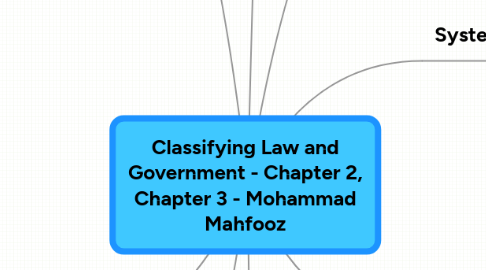
1. Passing a Law
1.1. Idea (from the Royal Commissions, Advisory Boards, Individual or Interest groups, or Ministers' Initiatives)
1.2. Draft Legislation
1.3. First Reading
1.3.1. Bill is Introduced
1.3.2. Minister may discuss purpose of bill
1.3.3. Background Information is supplied to opposition parties
1.3.4. Bill is printed and distributed
1.4. Second Reading
1.4.1. Principle of the Bill is debated
1.4.2. Minister may make a speech to open the debate
1.4.3. Each member can make only one speech
1.4.4. Bill may be referred to committee for revision and further examination
1.5. Third Reading
1.5.1. Debate is restricted to the contents of the bill
1.5.2. No amendments can be moved
1.6. Vote Held
1.6.1. Federal System
1.6.1.1. Steps are repeated in the Senate
1.6.1.2. Governor General
1.6.1.3. Royal Assent and Proclamation
1.6.2. Provincial System
1.6.2.1. Lieutenant-Governor
1.6.2.2. Royal Assent and Proclamation
2. Provincial Responsibilities
2.1. Education
2.2. Labour and Trade Unions
2.3. Compensation to Injured Workers
2.4. Direct taxation within the province
2.5. Natural Resources
2.6. Provincial Courts
3. Divisions of Law
3.1. Substantive Law (consists of laws that list the rights and duties of each person in society)
3.1.1. Public Law (controls the relationships between governments and people and represents laws that apply to everyone)
3.1.2. Private Law (outlines the legal relationships between private citizens and other private citizens/companies)
3.2. Procedural Law (outlines the steps involved in protecting the rights in substantive law)
4. Executive Branch
4.1. Federal Government
4.1.1. Queen
4.1.2. Governor General
4.1.3. Prime Minister
4.1.4. Cabinet
4.1.5. Public or Civil Service
4.2. Provincial Government
4.2.1. Queen
4.2.2. Lieutenant-Governor
4.2.3. Premier
4.2.4. Cabinet
4.2.5. Public or Civil Service
5. Legislative Branch
5.1. Federal Government
5.1.1. Governor General
5.1.2. Senate (upper house)
5.1.3. House of Commons (lower house)
5.2. Causation
5.2.1. Lieutenant-Governor
5.2.2. Legislative Assembly
6. Systems of Government
6.1. Unitary System
6.1.1. One Government
6.2. Federal System
6.2.1. Provincial Government
6.2.2. Federal Government
7. Federal Responsibilities
7.1. Banking
7.2. Criminal Law
7.3. Employment Insurance
7.4. Foreign Affairs
7.5. Indian Affairs
7.6. Marriage and Divorce
7.7. Residual Powers
7.7.1. Every other power that isn't listed, including ones that didn't exist at the time
8. Sources of Law
8.1. Constitutional Law
8.1.1. Constitutional Law is the boss law of Canada, that overrides all other laws. It comes from the Constitution Act of 1867, and the Constitution Act of 1982.
8.2. Statute Law
8.2.1. Statute Laws are laws passed by elected representatives in the form of acts.
8.3. Common Law
8.3.1. Also known as Case Law, law based off of previous judicial decisions.
